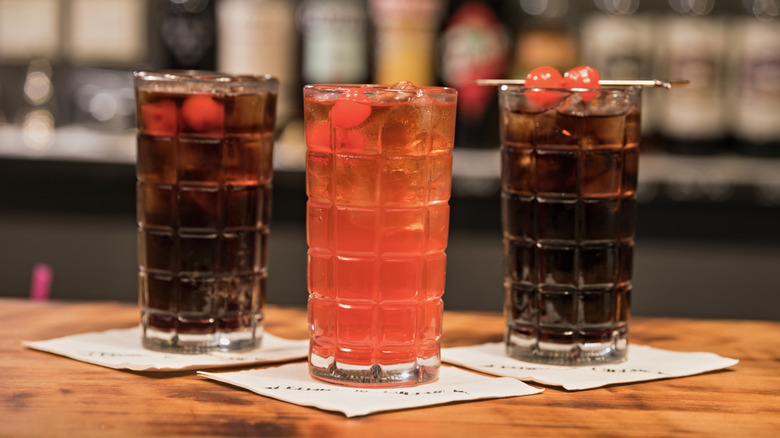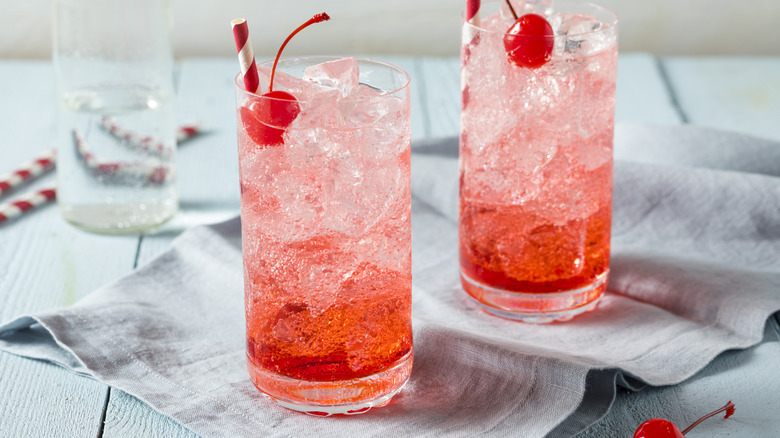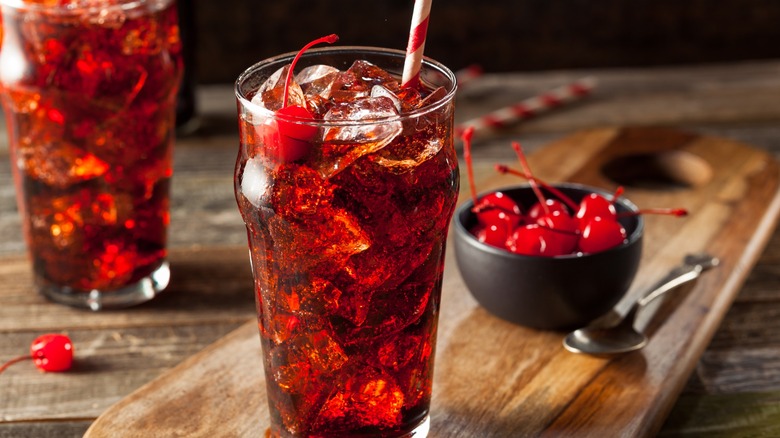Roy Rogers Vs Shirley Temple: The Difference Is Clear
Growing up, my parents would make it a point to celebrate New Year's Eve in a special way, and each year they would take my brother and I out to a fancy dinner. They'd make reservations, we'd all dress up, and it was the only time of the year I remember ordering what I thought was a very fancy drink: a Shirley Temple. My brother's highbrow beverage of choice was a Roy Rogers. I didn't know at the time, but our two bubbly drinks were practically identical. They both included grenadine syrup, a soft drink, and a maraschino cherry garnish. But while my brother's included cola, my Shirley Temple was based in ginger ale.
It's not unusual to use 7Up, Sprite, or any other lemon lime soda in place of ginger ale in Shirley Temples, but all in all, the soda is crystal clear before it's tinted Barbiecore pink from the sweet grenadine syrup (which surprisingly gets its unique flavor from pomegranate). Any cola will do for a Roy Rogers and, while it's difficult to see any color change in this drink, if you look very closely, you can detect a hint of cherry tint.
Kids love these two sugary sodas, but with mocktails experiencing a huge uptick in popularity, it's the perfect time to revisit both of these cherry-kissed sodas as adults, which you can order out practically anywhere or make at home.
Both beverages were inspired by pure Americana
Both the Roy Rogers and Shirley Temple drinks were named after beloved American entertainers known for their wholesome, family-friendly personas. Roy Rogers was a popular actor in the 1940s and '50s whose cowboy films and television shows made millions of kids aspire to be rootin' tootin', cowboy boot-wearin', lasso-twirlin' heroes, way before Tom Hanks' Sheriff Woody from "Toy Story" did. "The King of Cowboys," as he was known, didn't drink alcohol, and reportedly enjoyed sipping on sweet, effervescent cola mixed with grenadine, hence the drink's namesake.
The Shirley Temple existed before the Roy Rogers, and was inspired by the 1930s child star darling of the same name. Shirley Temple was bright and bubbly with a contagious, dimple-filled smile and bouncy blond curls, and it's easy to see how and why the drink was named after her, with its sweet, pink, and lively nature. The story goes that the soda-based beverage was created at Chasen's of Beverly Hills by a bartender who wanted Miss Temple to enjoy a mocktail while mingling with her much older (and tipple-toting) fellow celebrities. Like the actress, the Shirley Temple beverage also acted as a beacon of innocence and joy during a difficult time in American history, with the Great Depression upon the country, and the impending loom of World War II.
It's easy to make a 'dirty' Shirley Temple or Roy Rogers
Of course, it was only a matter of time before someone, somewhere decided to spike their favorite childhood soda drinks, thus creating the Dirty Shirley and Dirty Roy Rogers. The former is typically made with lemon-lime soda, grenadine, vodka, and fresh lime juice, with as many maraschino cherries garnishing the top as you'd like. For a grown up Dirty Roy Rogers, simply make a regular Roy Rogers and add whiskey, bourbon, or rum before adding your cherry garnish. Stir and sip your childhood away. Just kidding.
Shirley Temples and Roy Rogers' are, honestly, perfect the way they are and the fact that these booze-free beverages have withstood the test of time and remain a beloved choice for people of all ages is a testament to their tasty simplicity. But, you certainly can lighten up the sugar content by using trendy prebiotic sodas like Olipop and Poppi, or even diet soda that you can boost by squeezing in a bit of fresh lime juice and maybe adding some fresh mint leaves. You can practically hear Miss Temple's voice singing, "On the good ship, Olipop..." while sipping her pink soda that's good for her gut. Sorry, I had to.


